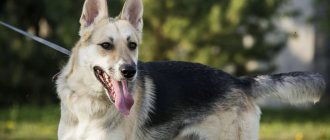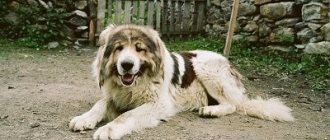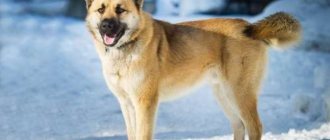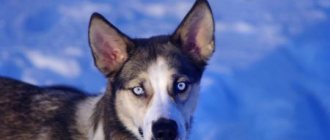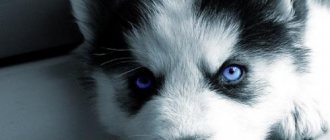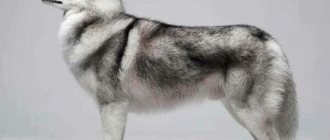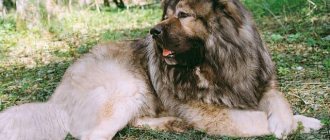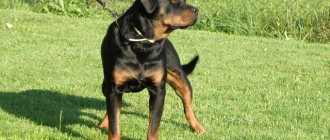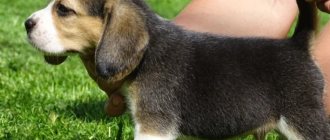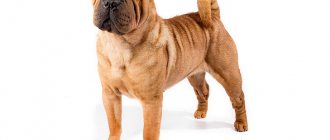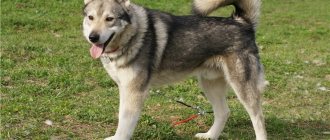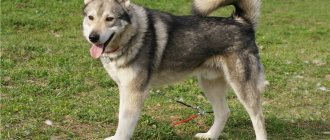The homeland of Siberian huskies is not so much Siberia as the Far East. In the vast areas of Chukotka and Kamchatka, these sled dogs have been bred by local residents for centuries using harsh but effective methods of “folk selection”. “Pure-bred” huskies with outstanding working qualities were valued very highly, which is not surprising, because not only the well-being, but also the life of their owners very often depended on the dogs.
At the beginning of the last century, during the Gold Rush, Siberian Huskies came to Alaska, where they gained fame as excellent sled dogs. This breed gained particular popularity after the famous relay race in 1925, the purpose of which was to deliver anti-diphtheria serum to the epidemic-stricken city of Nome.
Modern huskies, which are bred under this brand in the FCI system, may have retained the desire to run in harness and are sometimes used for their intended purpose in sports, but usually fanciers keep these dogs as pets.
Coat
The Husky has a "double coat" of medium length, giving the impression of good fur, but not so long as to hide the clean outer lines of the dog. The undercoat is soft and dense, also of sufficient length to support the guard hair. The guard hair is straight and lies quite smoothly, in no way hard and does not stand perpendicular to the surface of the skin. The absence of undercoat during the molting period is acceptable. The standard allows trimming of whiskers and hair between the toes and around the paws to give the dog a neat appearance. Trimming hair on any other parts of the body is unacceptable.
German Shepherd and Husky mix
He is registered with the AHDC (American Hybrid Dog Club). The club itself is not a member of the FCI (Fédération Cynologique Internationale), since it works contrary to the generally accepted statutes of the FCI: “Development and protection of cynology and purebred dog breeding.”
In the AHDC, a husky crossed with a shepherd has several names:
- German Husky;
- Siberian Shepherd;
- Husky Shepherd;
- Gerberian Shepsky.
In the Russian-language version, the mix took root under the shortened version Gerber Shepsi .
Desirable characteristics according to AHDC
Application
Working group (guard dog-companion).
Temperament
Affectionate, intelligent, socially adapted, energetic, playful, loyal to children and other pets dog with excellent intelligence. Alert, but not aggressive.
Adult size
Above average - from 60 to 65 cm at the withers.
- Males – 40-50 kg;
- Bitches – 30-35 kg.
Wool
The guard hair is thick, of medium length, without wavy, lying close to the body. The undercoat is soft, very dense and abundant, never exceeding the length of the guard hair.
Color
- black, white, brown, black-brown, fawn, golden, zone, pepper and salt, smoke or a harmonious combination of these colors;
- murugiy – acceptable color;
- piebald colors are not desirable;
- Harlequin or pockmarked colors are not acceptable.
Eyes
Oval or round without convexity. Eyelids black. It is desirable to have an “arrow” from the outer corner, characteristic of a husky. The color of the iris is all shades of blue to pale blue. An odd number of eyes is allowed (one is blue; the other is brown).
Tail
Not above the hock joints. Well pubescent, with long decorative hair. It can curl into a loose ring, but never lies on its back.
Difficulties of content
- long and heavy shedding;
- poor controllability, tendency to theft and escape.
Lifespan
Sexual dimorphism
Quite pronounced. The male should not create a feeling of massiveness, the female should have a lightweight type.
Character and behavior
Like all northern dogs, the husky has a unique character: friendly, but at the same time very independent and willful. This type of character developed over the centuries, because in the natural conditions of the Arctic, the dog’s intuition sometimes turned out to be more important than the owner’s commands. But what is vital in the tundra can become a significant burden in the city. Huskies are not very owner-oriented, they are not easy to train, and even in the best case, miracles of mutual understanding cannot be expected from them. They are prone to running away and wandering, picking up garbage, chasing cats and cars. Left unattended, a husky can destroy a room or dig up a yard in the blink of an eye. Huskies practically do not bark, but they can howl for hours on end.
Relationships with children Huskies, despite their “wolf” appearance, are very peaceful and calmly treat children, provided that the child himself does not bother the dog. In turn, children should know that the dog should not be disturbed while eating, and should not be pulled by the tail or ears. Very young children should not be left alone with the dog.
Relationships with animals The ancestors of huskies were sled dogs, accustomed to working in a harness, so modern huskies are friendly and sociable towards their relatives, although in case of aggression they can stand up for themselves. However, dogs of this breed have a very strong hunting instinct, so keeping a husky together with small domestic animals, be it a cat, rabbit or chicken, can be difficult.
Mixed husky and small dogs (pug, corgi)
Breeders used the following pets to produce crossbred Siberian dogs:
- Chihuahua. As a result of the only mating in history with this dog, the cub turned out to be more similar to the smaller parent; it took only the color of the eyes from the husky.
Mixed husky and pug
- Pug. The mixed breed was obtained by crossing the father of a Siberian sled breed and the mother of a pug. As a result, a puppy was born that looked almost nothing like its father, from whom he inherited only a playful character and activity. The crossbreeding of a Husky and a Pug, just like the crossbreeding of a Siberian sled dog with a Chihuahua, was an accident. At the same time, a cross between a Siberian and a pug is very popular.
- Corgi. The corgi hybrid looks like a miniature husky. Half-breeds have a very beautiful coat and eye color. Unlike the husky-pug hybrid, this cross is dominated by the genes of the larger dog. Horgi differs from purebred corgis in that they are smarter, friendlier and more active.
- Spitz. A cross between a Spitz and a Siberian sled dog is called a Pomsky. The hybrid is very popular abroad. The offspring are medium in size and have blue eyes. They are unpretentious and love walks and games. They become attached to their owner as strongly as purebred sled dogs.
Pointy-eared, round-headed, curious, agile, well-built dog with a pair of sapphire eyes on a pointed muzzle - a cross between a German shepherd and a husky - a cross that does not have breed status.
Health
Huskies are distinguished by good health. For example, there are practically no orthopedic diseases in the breed. However, owners need to pay attention to the dog's eyes and skin, as Huskies are prone to cataracts, progressive retinal atrophy, and allergic reactions.
Average life expectancy is 12–15 years.
Minuses
Tends to make independent decisions and is not known for good obedience. It considers small animals to be its rightful prey and, on occasion, can escape from its owners. Left to its own devices, it can cause considerable damage to your home. Loves to howl. Unsuitable for apartment keeping and keeping as an ordinary “pet”.
Mixed Caucasian Shepherd and Husky or mixed Alabai and Husky. What's better?
Several years ago, on the basis of the working kennel of the GUIN Ministry of Justice of the Russian Federation (Tomsk region), they tried to obtain a stable hybrid of the Central Asian Shepherd Dog and a Husky (a cross between a Husky and an Alabai).
Mixed husky and alabai
Caucasian Shepherd Dogs were also included in the experimental group, as representatives of strong and quite vicious breeds that have long established themselves as excellent representatives in the ZKS (protective guard service).
The goal of the experiment was to obtain powerful, large dogs with good protective and guard capabilities, which could easily endure difficult service in open space in Siberian frosts.
After a couple of years, the experiment was stopped. The dogs obtained through crossbreeding and their descendants demonstrated complete indifference to work, lack of necessary service qualities, and when trying to induce them, they fell into a rage.
Exercise stress
Huskies are, in the not too distant past, a “specialized” breed that was created for a specific purpose: to transport small loads at average speed, but over very long distances, sometimes measured in hundreds of kilometers. Therefore, even “domestic” huskies need serious physical activity. Ideally, they should be related to running, be it sledding, towing a skier, cycling together, or similar activities. From idleness and boredom, a husky can indulge in destructive activities or, at best, howl without stopping.
German and Husky mixes
Husky and Shepherd mix - registered with the American Mixed Dog Club (AHDC). The club is not an official organization and does not fit into the standard work of the canine system. Every breeder knows that a hybrid of two different dogs is not the best solution.
A mixture of both Husky and German Shepherd, according to the American community, has received several breed names:
- “Gerberian Shepsky” - Gerberian Shepsky;
- “Siberian Shepherd” – Siberian Shepherd Dogs;
- “German Husky” - German;
- “Husky Shepherd” - Herding huskies.
“Gerber sheps” - as they are often called in Russia, have become a common phenomenon in recent years.
Appearance and description of Gerber Shesya according to AHDC
- Group: working, guard, companion dogs.
- Height at the withers for a male: from 55 to 65 cm; weighing 35 – 50 kg;
- Females: 30 – 40 kg; height 45 – 55 cm.
Males are much larger and heavier than girls, while they are smaller and lighter. Outwardly, it is easy to distinguish between a boy and a girl.
- Coat: medium or long-haired dogs, with smooth and straight hair, rough and dense to the touch, well-defined undercoat - abundant, voluminous, dense in structure, soft to the touch.
Color: varied with different shades and saturation. The most common:
- Black;
- Black - brown;
- White;
- Brown;
- Chocolate;
- Red - red;
- Golden red;
- Black - gray;
- Zonal.
All representatives may have combinations of several colors; marbled coloring and piebald colors are not desirable.
Temperament and character: a cross between a husky and a German shepherd is hardy, smart, independent, alert, and not aggressive. Can live in families with children. Used as a guard, watchman.
